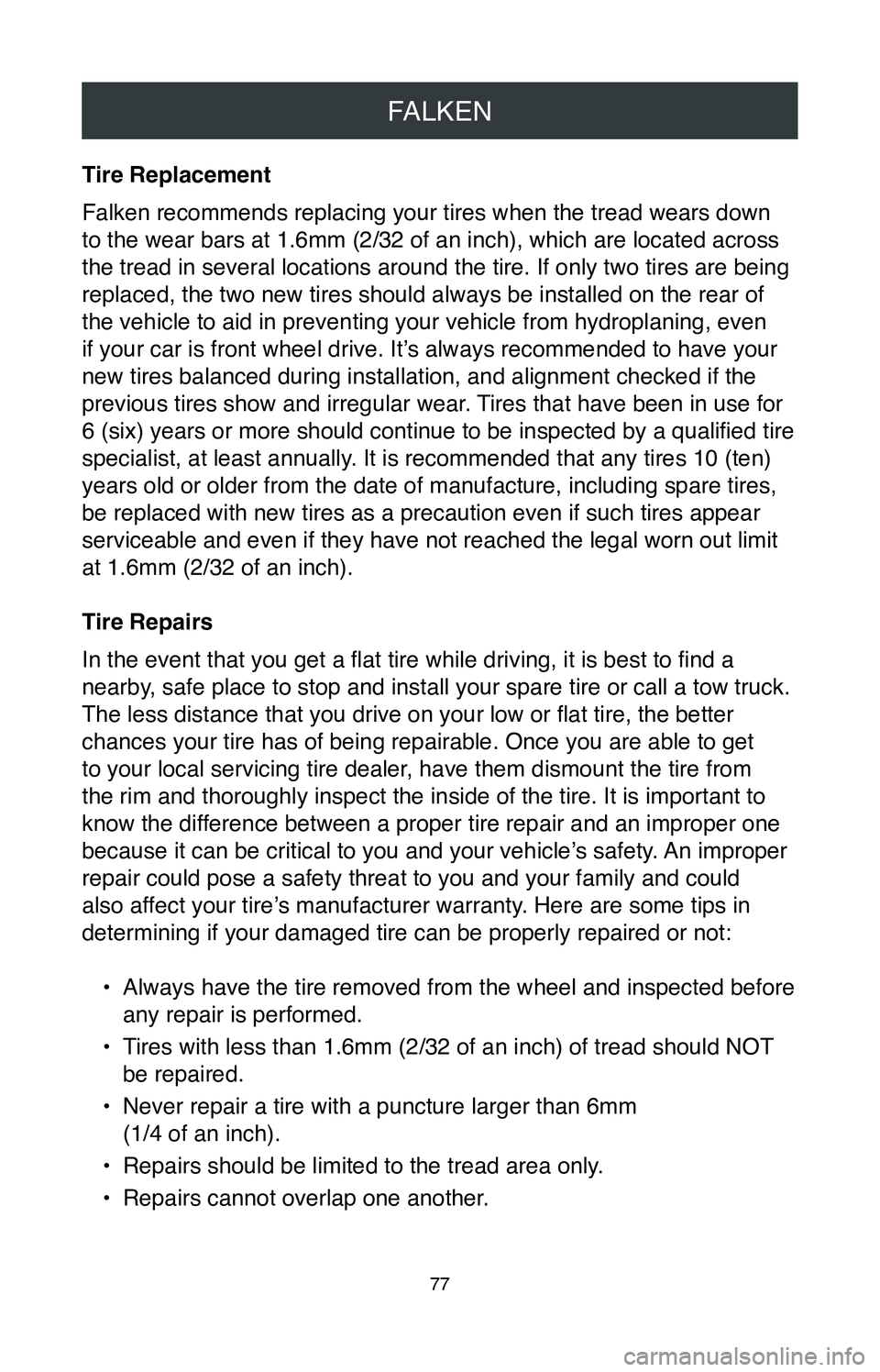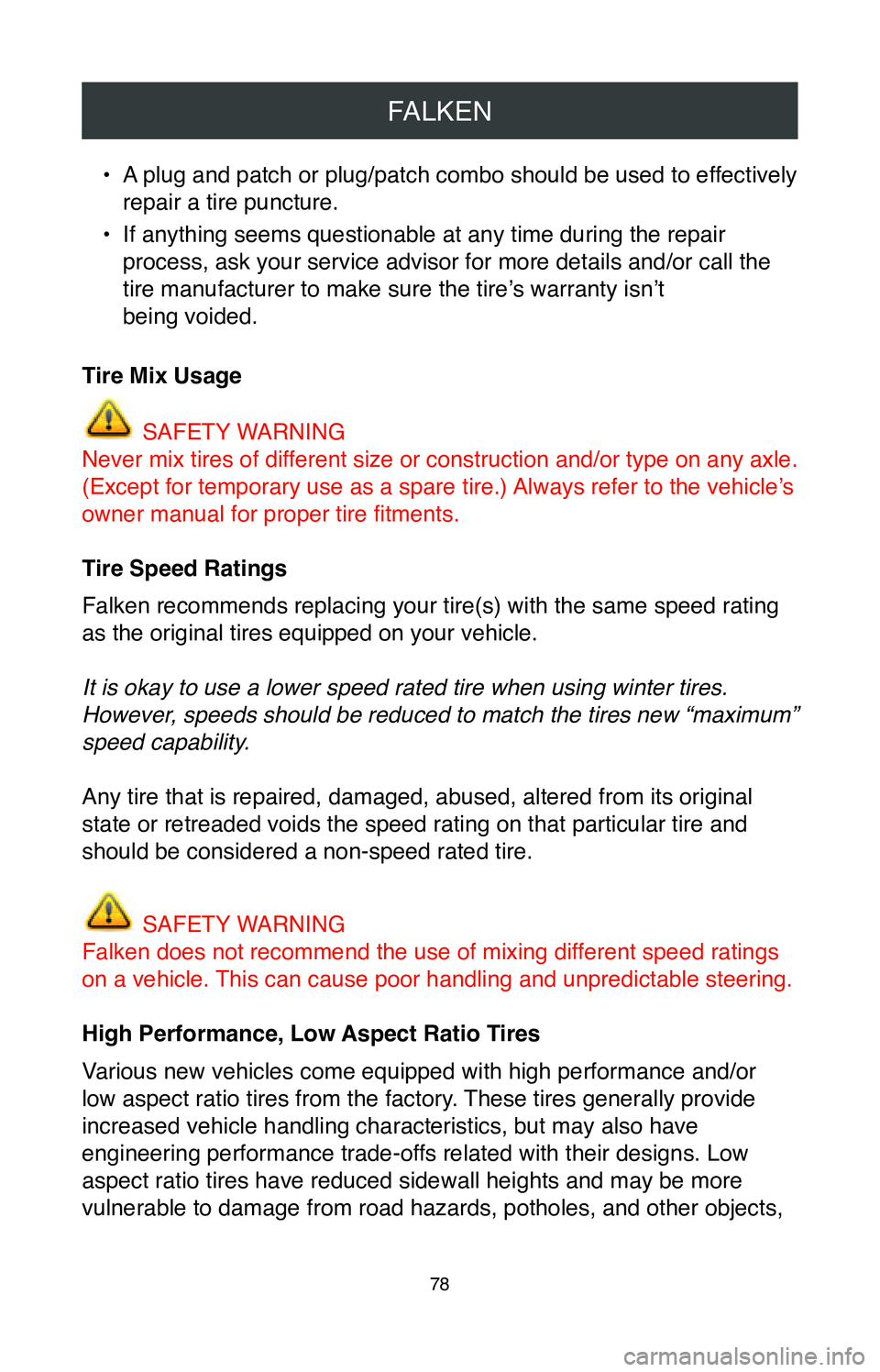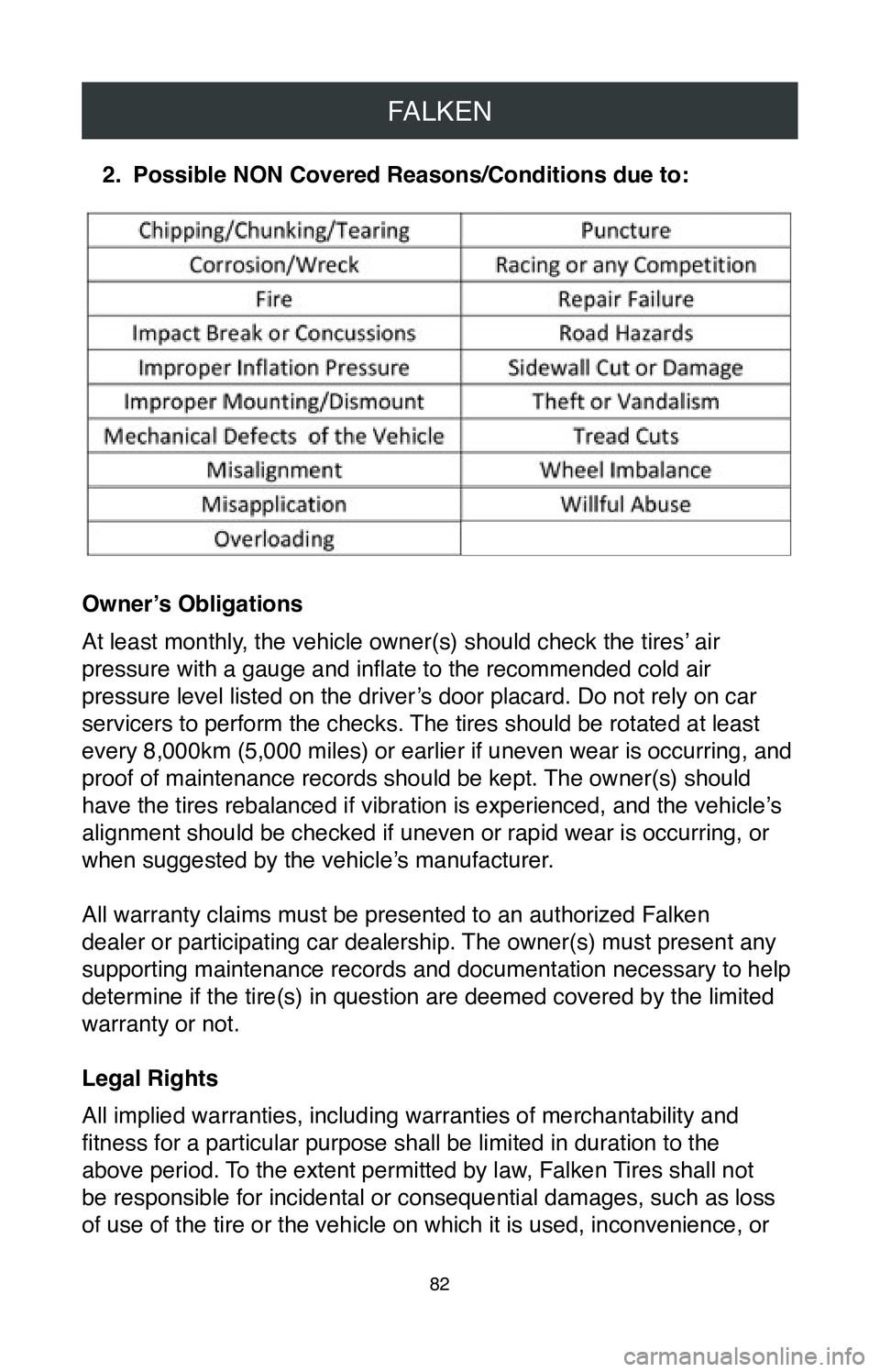2020 TOYOTA HIGHLANDER service
[x] Cancel search: servicePage 77 of 260

FALKEN
75
Your vehicle’s tire placard and/or owner’s manual will list the cold
inflation pressure(s) for your vehicle’s original equipment tires,
including the spare. The placard can be found on the driver’s side door
or door jamb area. If you have questions about understanding your
vehicle’s tire placard, please refer to your owner’s manual or ask a
qualified tire service professional.
Example of what
your vehicle
placard looks like:
Checking Your Tire’s Air Pressure
Checking your air pressure at least once a month is vital to help your
tires perform properly and help you get the best gas mileage possible.
Tires can lose up to 7 kPa (1 PSI) per month under normal conditions
and lose up to 7 kPa (1 PSI) per every 9°C (16°F) drop in temperature.
Here are some simple steps on how to check the air pressures in
your tires:1.
Remove the valve stem cap.
2.
Place the end of the tire gauge firmly against the tire’s valve stem.
3.
Read the current pressure displayed on the gauge that is
currently in the tire.
4.
Increase pressure at this time (if needed) and recheck with your
tire gauge.
5.
Replace the valve stem cap.
6.
Repeat until all of your tires have been checked and adjusted
accordingly.
Page 79 of 260

FALKEN
77
Tire Replacement
Falken recommends replacing your tires when the tread wears down
to the wear bars at 1.6mm (2/32 of an inch), which are located across
the tread in several locations around the tire. If only two tires are be\
ing
replaced, the two new tires should always be installed on the rear of
the vehicle to aid in preventing your vehicle from hydroplaning, even
if your car is front wheel drive. It’s always recommended to have your
new tires balanced during installation, and alignment checked if the
previous tires show and irregular wear. Tires that have been in use for
6 (six) years or more should continue to be inspected by a qualified tire
specialist, at least annually. It is recommended that any tires 10 (ten)
years old or older from the date of manufacture, including spare tires, \
be replaced with new tires as a precaution even if such tires appear
serviceable and even if they have not reached the legal worn out limit
at 1.6mm (2/32 of an inch).
Tire Repairs
In the event that you get a flat tire while driving, it is best to find a
nearby, safe place to stop and install your spare tire or call a tow truck.
The less distance that you drive on your low or flat tire, the better
chances your tire has of being repairable. Once you are able to get
to your local servicing tire dealer, have them dismount the tire from
the rim and thoroughly inspect the inside of the tire. It is important t\
o
know the difference between a proper tire repair and an improper one
because it can be critical to you and your vehicle’s safety. An improper
repair could pose a safety threat to you and your family and could
also affect your tire’s manufacturer warranty. Here are some tips in
determining if your damaged tire can be properly repaired or not:•
Always have the tire removed from the wheel and inspected before
any repair is performed.
•
Tires with less than 1.6mm (2/32 of an inch) of tread should NOT
be repaired.
•
Never repair a tire with a puncture larger than 6mm
(1/4 of an inch).
•
Repairs should be limited to the tread area only.
•
Repairs cannot overlap one another.
Page 80 of 260

FALKEN
78
• A plug and patch or plug/patch combo should be used to effectively
repair a tire puncture.
•
If anything seems questionable at any time during the repair
process, ask your service advisor for more details and/or call the
tire manufacturer to make sure the tire’s warranty isn’t
being voided.
Tire Mix Usage
SAFETY WARNING
Never mix tires of different size or construction and/or type on any axle.
(Except for temporary use as a spare tire.) Always refer to the vehicle’s
owner manual for proper tire fitments.
Tire Speed Ratings
Falken recommends replacing your tire(s) with the same speed rating
as the original tires equipped on your vehicle.
It is okay to use a lower speed rated tire when using winter tires.
However, speeds should be reduced to match the tires new “maximum”
speed capability.
Any tire that is repaired, damaged, abused, altered from its original
state or retreaded voids the speed rating on that particular tire and
should be considered a non-speed rated tire.
SAFETY WARNING
Falken does not recommend the use of mixing different speed ratings
on a vehicle. This can cause poor handling and unpredictable steering.
High Performance, Low Aspect Ratio Tires
Various new vehicles come equipped with high performance and/or
low aspect ratio tires from the factory. These tires generally provide
increased vehicle handling characteristics, but may also have
engineering performance trade-offs related with their designs. Low
aspect ratio tires have reduced sidewall heights and may be more
vulnerable to damage from road hazards, potholes, and other objects,
Page 81 of 260

FALKEN
79
like curbs. Your vehicle’s wheels are susceptible to these same
dangers as well. Some vehicles may be originally equipped with high
performance tires that are designed for warmer weather use reducing
traction in colder, winter weather conditions. High performance tires
also pose the possibility of wearing more quickly, giving a stiffer ride,
and producing louder noise than standard all-season tires during
operation. Refer to your vehicle owner’s manual, tire information
placard, or qualified tire service professional for more information about
these kinds of tires.
Winter Tires
Falken recommends all four tires be replaced when replacing your
original equipment tires and installing winter tires for the winter mont\
hs.
SAFETY WARNING
Never use just two winter tires. It could lead to adverse handling, loss
of control, which could cause serious injury or death.
Storing Your Tires
When storing your tires for any extended period of time, be sure to
thoroughly clean your tires with a tire brush, soap, and water to remove\
any dirt, salt, and brake dust from the tires. If you are storing your
tires still mounted on the wheels, use a wheel brush and approved
wheel cleaner to clean your wheels. Then dry the wheels and tires
with a towel and allow them to fully dry. DO NOT apply any tire
dressings while storing your tires. Tire compounds are made to resist
weather cracking and ozone damage. Place each clean and dry tire
in an airtight plastic bag and seal the bag with tape to help reduce oil\
evaporation. Store your tires out of direct sunlight and somewhere that \
is well shielded from the elements, like a climate-controlled room or
dry basement. Storing the tires in a garage or shed usually exposes
the tires to a wide range of temperatures as well as precipitation and
humidity. Keep the tires away from sources that emit ozone like electric
motors that use contact brushes, furnaces, sump pumps, etc. Although
tires will still age regardless of how they are stored, these precaution\
s
will help slow the aging process and reduce the damage to your tires.
Page 82 of 260

FALKEN
80
Speed Limits
SAFETY WARNING
Operating your vehicle in excess of the posted speed limit or the
maximum speed allotted by driving conditions has the potential to be
dangerous. Higher driving speeds create excessive heat buildup in a
tire, leading to a possible tire failure.
Tire Spinning
SAFETY WARNING
Spinning a tire to get a stuck vehicle out of mud, ice, snow, sand,
or wet grass can be potentially dangerous. A spinning tire at a
speedometer reading above 55 km/h (35 mph) can be capable of
disintegrating a tire with explosive force. In some circumstances, a tir\
e
may be spinning at twice the speed displayed on the speedometer.
This can cause serious injury or death to you, a passenger, or
bystander. Never spin a tire above 55 km/h (35 mph).
Limited Warranty
This limited warranty applies to Falken brand Original Equipment
Passenger Car, Temporary Spare, and Light Truck steel belted radial
tires bearing the complete description and serial number required by
the Department of Transportation (DOT). This warranty is effective only
to tires for which claims are made within 6 (six) years of the date of
production, based on the tire DOT serial number.
What Is Covered and for How Long
Falken tires that are originally equipped on this vehicle are warranted \
against any defects in the materials and workmanship for the usable
life of the original tread. The limited warranty terminates at the flush
appearance of the tread wear indicators at 1.6mm (2/32 of an inch)
remaining tread depth.
a.
Free Replacement
If a tire becomes unserviceable due to such defect within the first
1.6mm (2/32 of an inch) of tread wear, the tire will be replaced
Page 83 of 260

FALKEN
81
free of charge with the same or comparable Falken tire (mounting
and balancing labor covered).
b.
Prorated Replacement
After the first 1.6mm (2/32 of an inch) of wear, a prorated
adjustment credit will be given based on the percentage of
remaining usable tread depth, down to the remaining 1.6mm (2/32
of an inch) tread wear bar indicator (mounting and balancing labor
covered). No credit is given if the tire is worn beyond the flush
appearance of the tread wear bar indicator (less than 1.6mm
(2/32 of an inch) tread depth remaining).
c.
Out-of-Round / Out-of-Balance Replacement
Tires that are deemed to be out-of-round or out-of-balance will be
accepted for adjustment during the first 0.8mm (1/32 of an inch)
of the original tread depth and will be replaced free of charge with
the same or similar Falken tires (mounting and balancing labor
covered). A set of four (4) tires from the same vehicle will not be
accepted for out-of-round or out-of-balance claims.
What Is Not Covered by the Warranty 1.
a. Tires that become unserviceable due to road hazard
damages (cuts, snags, punctures, bruises, impact breaks,
etc.) improper repair technique or materials, improper
inflation, overload, irregular wear, wheel imbalance, defective
mechanical vehicle components (brakes, suspension,
wheels, etc.) improper suspension alignment, accident, fire,
chemical damage, damage from chain use, racing, off-road
use, run flat, improper installation, vandalism, or abuse.
b.
Tires branded “NA” or a tire in which the DOT numbering has
been removed.
c.
Tires that were transferred to another vehicle from the
vehicle in which the tires were originally installed.
d.
Tires having a failure or failures caused by a previous
damages or repairs.
e.
The cost of tire repair or retreading is not covered by this
warranty and will be the sole responsibility of the tire owner.
Page 84 of 260

FALKEN
82
2. Possible NON Covered Reasons/Conditions due to:
Owner’s Obligations
At least monthly, the vehicle owner(s) should check the tires’ air
pressure with a gauge and inflate to the recommended cold air
pressure level listed on the driver’s door placard. Do not rely on car
servicers to perform the checks. The tires should be rotated at least
every 8,000km (5,000 miles) or earlier if uneven wear is occurring, and
proof of maintenance records should be kept. The owner(s) should
have the tires rebalanced if vibration is experienced, and the vehicle’s
alignment should be checked if uneven or rapid wear is occurring, or
when suggested by the vehicle’s manufacturer.
All warranty claims must be presented to an authorized Falken
dealer or participating car dealership. The owner(s) must present any
supporting maintenance records and documentation necessary to help
determine if the tire(s) in question are deemed covered by the limited
warranty or not.
Legal Rights
All implied warranties, including warranties of merchantability and
fitness for a particular purpose shall be limited in duration to the
above period. To the extent permitted by law, Falken Tires shall not
be responsible for incidental or consequential damages, such as loss
of use of the tire or the vehicle on which it is used, inconvenience, or\
Page 86 of 260

FALKEN
84
Date of Tire Manufacture
The date that a tire was manufactured can be determined by
examining the last 4 digits of the 12 digit DOT serial code, which is
found on at least one sidewall of a tire. For tires that were produced
after the year 2000, the last 4 digits of the serial code will identify the
week and the year that the tire was manufactured. If the last 4 digits
in the DOT serial code were to read “0517” it would mean that the tire
was manufactured the 5th week of 2017. If you are uncertain, check
with a qualified tire service professional to be sure.
DOT Symbol and DOT Serial Code
The “DOT” symbol claims that the tire conforms to all applicable US
Department of Transportation motor vehicle safety standards for tires.
The identification/serial number follows the “DOT” symbol. Here is an
example of a DOT serial code:
DOT R8 20 4M4R 05 17
(A) (B) (C) (D) (E) (F)
A) DOT Symbol
B) Manufacturer Plant Code
C) Tire Size Code
D) Tire Manufacturer’s Code
E) Week of Production (01-52)
F) Year of Production (the last two digits of the year)